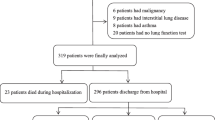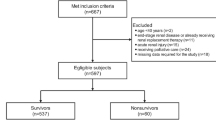Abstract
Serum uric acid (UA), the final product of purine degradation, has been shown to be increased in the hypoxic state. We assessed whether the presence of higher values of serum UA and serum UA to creatinine ratio is associated with clinical or functional characteristics in patients with chronic obstructive pulmonary disease (COPD). Fifty-nine consecutive stable patients with COPD, without comorbid conditions, were included. Clinical and functional characteristics were compared between patients with levels below and above the median values of serum UA and serum UA to creatinine ratio. Patients with serum UA levels above the median value differed significantly from the group with levels below this value only in FVC (p = 0.04), and serum UA did not correlate significantly with the parameters analyzed. Patients with the serum UA to creatinine ratio above the median value had lower FVC (63 ± 18 vs. 73 ± 15 percentage of predicted, p = 0.028), lower FEV1 (43 ± 19 vs. 55 ± 18 percentage of predicted, p = 0.019), and a higher level of dyspnea (MRC scale, 1.5 ± 1.1 vs. 0.8 ± 1.0, p = 0.011). The serum UA to creatinine ratio correlated with FVC (r = −0.27), with FEV1 (r = −0.31), and with dyspnea (r = 0.29). In view of these results, we consider that the serum UA to creatinine ratio warrants evaluation as an additional parameter for predicting outcome in COPD.
Similar content being viewed by others
References
Anker SD, Doehner W, Rauchhaus M, et al. (2003) Uric acid and survival in chronic heart failure: validation and application in metabolic, functional, and hemodynamic staging. Circulation 107:1991–1997
Braghiroli A, Sacco C, Erbetta M, et al. (1993) Overnight urinary acid/creatinine ratio for detection of sleep hypoxemia: validation study in chronic obstructive pulmonary disease and obstructive sleep apnea before and after treatment with nasal continuous positive airway pressure. Am Rev Respir Dis 148:173–178
Celli B, MacNee W (2004) Standards for the diagnosis and treatment of patients with COPD: a summary of the ATS/ERS position paper. Eur Respir J 23:932–946
Collaborative Group on Intracellular Monitoring (1988) Intracellular monitoring of experimental respiratory failure. Am Rev Respir Dis 138:484–487
De Torres JP, Cordoba-Lanus E, Lopez-Aguilar C, et al. (2006) C-reactive protein levels and clinically important predictive outcomes in stable COPD patients. Eur Respir J 27:902–907
Elsayed NM, Nakashima JM, Poslethwait EM (1993) Measurement of uric acid as a marker of oxygen tension in the lung. Arch Biochem Biophys 302:228–232
Gosker HR, Bast A, Haenen GR, et al. (2005) Altered antioxidant status in peripheral skeletal muscle of patients with COPD. Respir Med 99:118–125
Hasday JD, Grum CM (1987) Nocturnal increase of urinary uric acid/creatinine ratio: a biochemical correlate of sleep-associated hypoxemia. Am Rev Respir Dis 135:534–538
Kojima S, Sakamoto T, Ishihara M, et al. (2005) Prognostic usefulness of serum uric acid after acute myocardial infarction. The Japanese Acute Coronary Syndrome Study. Am J Cardiol 96:489–495
Lewis JG, Gardner JE (1960) The relation of serum uric acid to haemoglobin level in patients with cardiac and respiratory disease. J Clin Pathol 13:502–505
Lopez IH (2003) Serum uric acid levels among patients with chronic obstructive pulmonary disease [abstract]. Chest 124:168S
Mahler DA, Harver A (1992) A factor analysis of dyspnea ratings, respiratory muscle strength, and lung function n patients with chronic obstructive pulmonary disease. Am Rev Respir Dis 145:467–470
Marangella M (2005) Uric acid elimination in the urine. Pathophysiological implications. Contrib Nephrol 147:132–148
Mateos Anton F, Garcia Puig J, Gomez Fernandez P, Ramos Hernandez T, Lopez Jimenez M (1989) Degradation of purine nucleotides in patients with chronic airflow obstruction [in Spanish]. Med Clin (Barc) 92:328–330
McKenon JL, Saunders NA, Murree-Allen K, et al. (1990) Urinary uric acid to creatinine ratio, serum erythropoietin, and blood 2,3-disphosphoglycerate in patients with obstructive sleep apnea. Am Rev Respir Dis 142:8–13
Nagaya N, Uematsu M, Satoh T, et al. (1999) Serum uric acid levels correlate with the severity and the mortality of primary pulmonary hypertension. Am J Respir Crit Care Med 160:487–492
Oya H, Nagaya N, Satoh T, et al. (2000) Haemodynamic correlates and prognostic singificance of acid uric in adult patients with Eisenmeneger syndrome. Heart 84:53–58
Roca J, Sanchis J, Agusti-Vidal A, et al. (1985) Spirometric reference values from a Mediterranean population. Bull Eur Physiopathol Respir 22:217–224
Ruggiero C, Cherubini A, Ble A, et al. (2006) Uric acid and inflammatory markers. Eur Heart J 27:1174–1181
Saito H, Nishimura M, Shibuya E, et al. (2002) Tissue hypoxia in sleep apnea syndrome assessed by uric acid and adenosine. Chest 122:1686–1694
Sato N, Kurashima K, Ubukata M, et al. (2003) Prognostic significance of serum uric acid in patients with chronic obstructive pulmonary disease receiving home oxygen therapy [in Japanese; abstract in English]. 41:74–80
Shimizu Y, Nagaya N, Satoh T, et al. (2002) Serum acid uric level increases in proportion to the severity of pulmonary thromboembolism. Circ J 66:571–575
Author information
Authors and Affiliations
Corresponding author
Rights and permissions
About this article
Cite this article
Garcia-Pachon, E., Padilla-Navas, I. & Shum, C. Serum Uric Acid to Creatinine Ratio in Patients with Chronic Obstructive Pulmonary Disease. Lung 185, 21–24 (2007). https://doi.org/10.1007/s00408-006-0076-2
Accepted:
Published:
Issue Date:
DOI: https://doi.org/10.1007/s00408-006-0076-2




